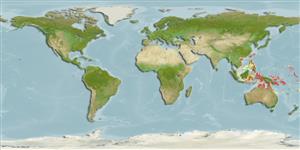>
Gobiiformes (Gobies) >
Gobiidae (Gobies) > Gobiinae
Etymology: Fusigobius: Latin, fusus = spindle + Latin, gobius = gudgeon (Ref. 45335); aureus: aureus (Latin for yellow) referring to the many 'golden-yellow' spots scattered on the body and fins (Ref. 31555).
Environment: milieu / climate zone / depth range / distribution range
Ökologie
seewasser riff-verbunden; tiefenbereich 5 - 25 m (Ref. 90102). Tropical
Western Central Pacific: Indonesia, Solomon Islands, and the Coral Sea.
Size / Gewicht / Alter
Maturity: Lm ? range ? - ? cm
Max length : 3.5 cm SL Männchen/unbestimmt; (Ref. 31555)
Kurzbeschreibung
Bestimmungsschlüssel | Morphologie | Morphometrie
Rückenflossenstacheln (insgesamt) : 7; Rückenflossenweichstrahlen (insgesamt) : 9; Afterflossenstacheln: 1; Afterflossenweichstrahlen: 8. Pectorals large and rounded; pelvic fins largely separated but united at base, the connecting membrane very short and concave in outer margin, without inter-spine frenum (Ref. 31555). Body with a row of golden-yellow spots along mid-line of lateral surfaces and with some rows of smaller golden-yellow spots on both dorsal and ventral surfaces. An oblique, yellow line on cheek and snout. Caudal base with a diaper-shaped black blotch. Dorsal and caudal fins with some rows of smaller golden-yellow spots. First dorsal with a large black blotch, with its lower half tinged orange. Pelvic fins largely separated except for a limited linkage by a very narrow connecting membrane (Ref. 31555); characterized further by having rounded caudal fin; longitudinal scale series 24-25; ctenoid body scales becoming cycloid anterior to pectoral and pelvic fins; absence of scales on operculum; opening of gill extending to or almost to vertical at posterior edge of preopercle; depth of body 4.3-4.8 in SL (Ref. 90102).
Inhabits seaward reefs in 5-25 m (Ref. 90102).
Life cycle and mating behavior
Maturities | Fortpflanzung | Spawnings | Egg(s) | Fecundities | Larven
Chen, I.-S. and K.-T. Shao, 1997. Fusigobius aureus, a new species of gobiid fish (Perciformes, Gobiidae) from Flores Island, Indonesia. Acta Zool. Taiwanica 8(2):87-92. (Ref. 31555)
IUCN Rote Liste Status (Ref. 130435)
Bedrohung für Menschen
Harmless
Nutzung durch Menschen
Tools
Zusatzinformationen
Download XML
Internet Quellen
Estimates based on models
Preferred temperature (Ref.
123201): 27.4 - 29.4, mean 28.8 °C (based on 1078 cells).
Phylogenetic diversity index (Ref.
82804): PD
50 = 0.5005 [Uniqueness, from 0.5 = low to 2.0 = high].
Bayesian length-weight: a=0.01023 (0.00477 - 0.02194), b=3.02 (2.84 - 3.20), in cm total length, based on LWR estimates for this (Sub)family-body shape (Ref.
93245).
Trophic level (Ref.
69278): 3.2 ±0.3 se; based on size and trophs of closest relatives
Widerstandsfähigkeit (Ref.
120179): hoch, Verdopplung der Population dauert weniger als 15 Monate. (Preliminary K or Fecundity.).
Fishing Vulnerability (Ref.
59153): Low vulnerability (10 of 100).
